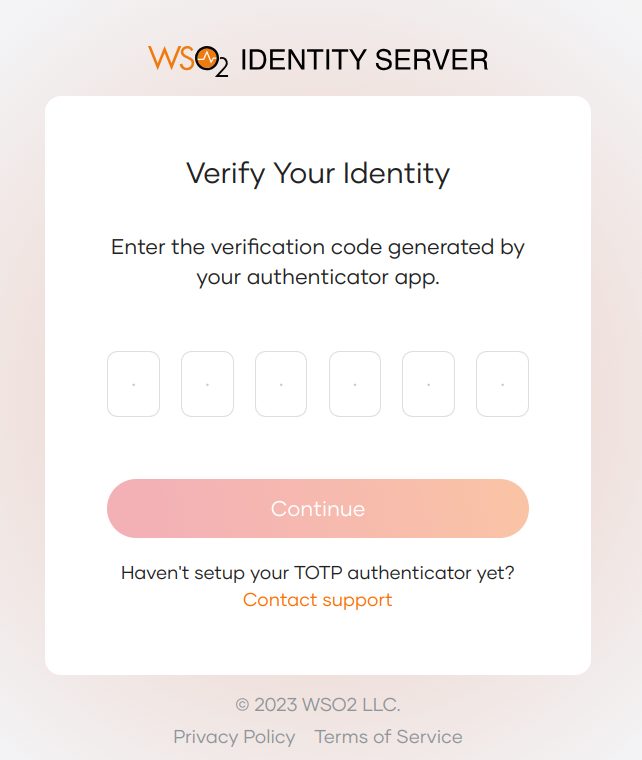Add MFA based on IP address¶
You can secure the login flow based on the user's IP address by applying the IP-Based conditional authentication template to your application. This template prompts two-factor authentication for users who log in from outside a given IP range (such as external networks or other geographical locations).
Scenario¶
Consider a scenario where the internal IPs of an organization are as follows: 192.168.1.0/24, 10.100.0.0/16. The login flow should be stepped up with TOTP when users log in from outside this IP range as follows:
- Username and password
- TOTP
Users who log in from the internal network should be allowed to simply log in with their username and password.

Prerequisites¶
You need to register an application with WSO2 Identity Server. You can register your own application or use one of the sample applications provided.
Configure the login flow¶
To enable conditional authentication:
-
On the WSO2 Identity Server Console, click Applications.
-
Select the relevant application and go to it's Login Flow tab.
-
Add IP-based adaptive MFA using your preferred editor:
-
Go to Predefined Flows > Conditional Login Flows.
-
Click Adaptive MFA > IP-Based > ADD to add the IP-based adaptive MFA script.
-
Click Confirm to replace any existing script with the selected predefined script.
-
-
Verify that the login flow is now updated with the following two authentication steps:
- Step 1: Username and Password
- Step 2: TOTP
-
Update the following parameter in the script.
Parameter Description corpNetworkComma separated list of IP addresses. Two-factor authentication should apply when users log in from outside this range. The default values in the template are 192.168.1.0/24and10.100.0.0/16. -
Click Update to confirm.
How it works¶
Shown below is the script of the IP-based conditional authentication template.
// Configure the network ranges here
var corpNetwork = ['192.168.1.0/24', '10.100.0.0/16'];
var onLoginRequest = function(context) {
executeStep(1, {
onSuccess: function (context) {
var user = context.currentKnownSubject;
// Extracting the origin IP of the request
var loginIp = context.request.ip;
Log.info('User: ' + user.username + ' logged in from IP: ' + loginIp);
// Checking if the IP is within the allowed range
if (!isCorporateIP(loginIp, corpNetwork)) {
executeStep(2);
}
}
});
};
// Function to convert ip address string to long value
var convertIpToLong = function(ip) {
var components = ip.split('.');
if (components) {
var ipAddr = 0, pow = 1, i = 3;
return getIpAddrInLong(ipAddr, i, pow, components);
} else {
return -1;
}
};
// Function to convert ip address string to long value
var getIpAddrInLong = function(ipAddr, i, pow, components) {
if (i >= 0) {
ipAddr += pow * parseInt(components[i]);
pow *= 256;
i -= 1;
return getIpAddrInLong(ipAddr, i, pow, components);
} else {
return ipAddr;
}
};
// Function to check if the ip address is within the given subnet
var isCorporateIP = function (ip, subnets, i) {
if (i === undefined) {
i = 0;
}
if (i < subnets.length) {
var subnetComponents = subnets[i].split('/');
var minHost = convertIpToLong(subnetComponents[0]);
var ipAddr = convertIpToLong(ip);
var mask = subnetComponents[1];
if (subnetComponents && minHost >= 0) {
var numHosts = Math.pow(2, 32 - parseInt(mask));
if ((ipAddr >= minHost) && (ipAddr <= minHost + numHosts - 1)) {
return true;
}
}
i++;
return isCorporateIP(ip, subnets, i);
} else {
return false;
}
};
Let's look at how this script works.
-
The convertIpToLong function converts and returns the provided IP address as a long value.
-
The isCorporateIP function returns whether the user's IP address is in the given range. This method accepts two inputs. The first argument is the IP address that should be validated and the second argument is the allowed IP range.
-
When step 1 of the authentication flow is complete, the onLoginRequest function retrieves the IP address of the user from the context.
-
This IP address is passed to the isCorporateIP function along with the configured IP address range.
-
If the IP address of the logged-in user is not in the configured IP range, step 2 of the authentication flow is executed.
Note
Find out more about the scripting language in the Conditional Authentication API Reference.
Try it out¶
Follow the steps given below.
-
Access the application URL.
-
Try to log in with a user whose IP address is in the configured range. You will successfully log in to the application.
-
Log out of the application.
-
Log in with a user who does not belong to the configured IP address range. TOTP authentication is prompted.
